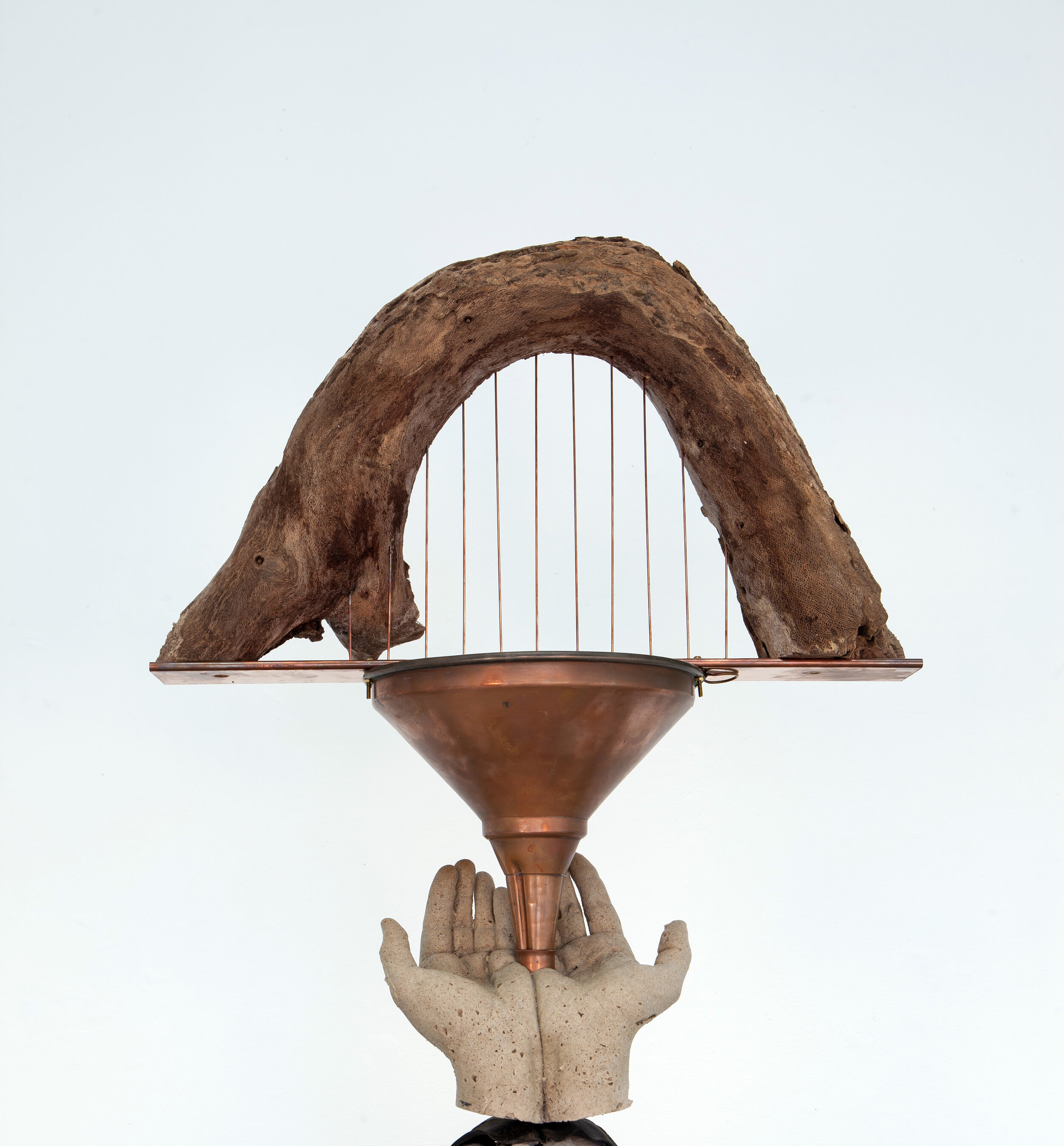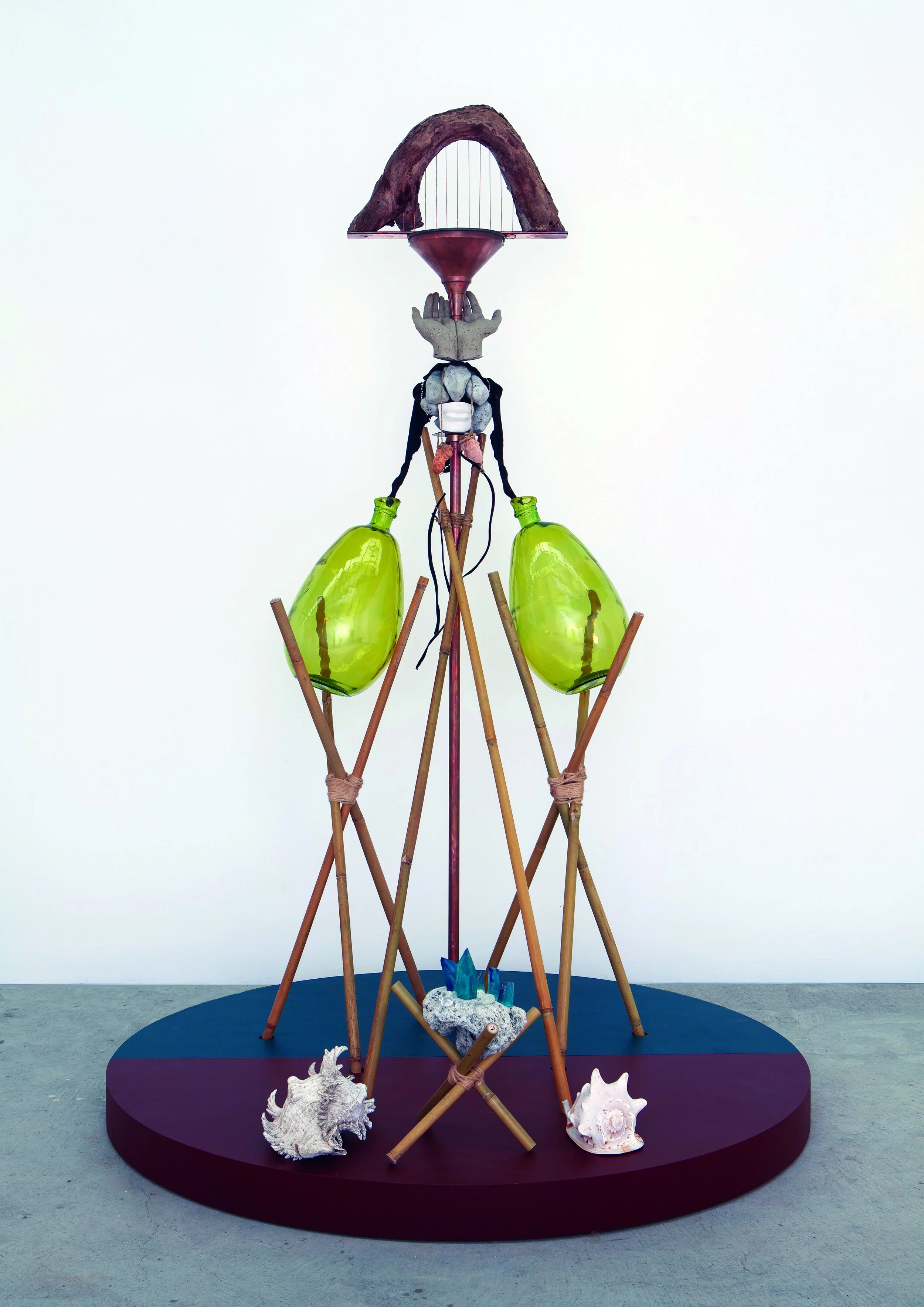






collected Tasmanian Bull Kelp (Durvillaea potatorum) and stipes, salt derived from land grown Sarconema seaweed, Bribie Island, QLD (Seaweed Research Group, SCU), Himalayan pink salt, Pakistan, found pumice from 2012 Havre seamount eruption of Kermadec Islands, New Zealand (School of Earth & Atmospheric Sciences QUT), beach sand, NSW, Found drift wood, copper wire, copper tube, found copper funnel, U.S.A, found recycled glass demijohns, Spain, bamboo, gifted conch shells, blue tooth speakers, MP3, ‘Lisa’s Song’ played on giant bull kelp stipe lxilongo flute by Pedro Espi-Sanchis, sodium alginate, calcium carbonate, agar agar, citric acid, H20
VIRIDITAS playfully entangles currents of thought, technology, material and song. Patchworking our tools and relationships together as DIY maps of survival, songs of future nostalgia, circular economies and elemental ecologies. It reframes our relationships to living entities (macroalgae /seaweed), the elements (water), and currencies. Our currencies change, and driftwood becomes high commodity, our landscapes change, and forests become deserts… our haute couture- made of seaweed.
In assembling VIRIDITAS, tentacular collaborations trace along coastlines to the Seaweed Research Group of the University of the Sunshine Coast QLD, the Seaweed Appreciation Society international (SASi) VIC, Prosthetic Art Technology (PAT) NSW, and across the seas to music magician and educator Pedro Espi-Sanchis in Cape Town, South Africa.
ACKNOWLEDGEMENTS + COLLABORATORS:
Music: ‘Lisa’s Song’ performed by Pedro Espi-Sanchis on a giant bull kelp (Ecklonia) stipe lxilongo flute
Sarconema Salt + Seaweed Research: Professor Nick Paul, Dr. Alexandra Campbell, Dr Libby Swanepoel and Ana Wegner of the Seaweed Research Group, USC. QLD;
Pumice: Dr Scott Bryan and Joseph Knafelc from School of Earth & Atmospheric Sciences, QUT. QLD
Mould making consultant: Clinical Anaplastologist Sophie Fleming from Prosthetic Art Technology (PAT), NSW;
Experimental Seaweed platform: Lichen Kelp from Seaweed Appreciation Society international (SASi), VIC;
Beach cast Tasmanian Bull Kelp (Durvillaea): collected by Chris Russell from Kelpomix, Devonport, TAS;
Title + artwork inspired by Robin Wall Kimmerer and Donna J.Haraway.

collected Tasmanian Bull Kelp (Durvillaea potatorum) and stipes, salt derived from land grown Sarconema seaweed, Bribie Island, QLD (Seaweed Research Group, SCU), Himalayan pink salt, Pakistan, found pumice from 2012 Havre seamount eruption of Kermadec Islands, New Zealand (School of Earth & Atmospheric Sciences QUT), beach sand, NSW, Found drift wood, copper wire, copper tube, found copper funnel, U.S.A, found recycled glass demijohns, Spain, bamboo, gifted conch shells, blue tooth speakers, MP3, ‘Lisa’s Song’ played on giant bull kelp stipe lxilongo flute by Pedro Espi-Sanchis, sodium alginate, calcium carbonate, agar agar, citric acid, H20.
VIRIDITAS offers an ecology of ideas, phenomena, materials and interactions between the shoreline and the ocean. It responds to the short speculative fiction piece 50 Mile Bone Beach (Pamela Jeffs) by collecting motifs and sentiments sifted within the written piece. These found motifs and sentiments are relocated to assemble the artwork VIRIDITAS; and are noted in italics below:
I am the collector
Ash coloured
Crimson
Sentimental
Community
Salt-slick
Piece of music
Sand
Sky
Patchwork of old tech
My ocean of derelict beauty
Tears prick the back of my eyes
ACKNOWLEDGEMENTS + COLLABORATORS:
Music: ‘Lisa’s Song’ performed by Pedro Espi-Sanchis on a giant bull kelp (Ecklonia) stipe lxilongo flute
Sarconema Salt + Seaweed Research: Professor Nick Paul, Dr. Alexandra Campbell, Dr Libby Swanepoel and Ana Wegner of the Seaweed Research Group, USC. QLD;
Pumice: Dr Scott Bryan and Joseph Knafelc from School of Earth & Atmospheric Sciences, QUT. QLD
Mould making consultant: Clinical Anaplastologist Sophie Fleming from Prosthetic Art Technology (PAT), NSW;
Experimental Seaweed platform: Lichen Kelp from Seaweed Appreciation Society international (SASi), VIC;
Beach cast Tasmanian Bull Kelp (Durvillaea): collected by Chris Russell from Kelpomix, Devonport, TAS;
Title + artwork inspired by Robin Wall Kimmerer and Donna J.Haraway.

collected Tasmanian Bull Kelp (Durvillaea potatorum) and stipes, salt derived from land grown Sarconema seaweed, Bribie Island, QLD (Seaweed Research Group, SCU), Himalayan pink salt, Pakistan, found pumice from 2012 Havre seamount eruption of Kermadec Islands, New Zealand (School of Earth & Atmospheric Sciences QUT), beach sand, NSW, Found drift wood, copper wire, copper tube, found copper funnel, U.S.A, found recycled glass demijohns, Spain, bamboo, gifted conch shells, blue tooth speakers, MP3, ‘Lisa’s Song’ played on giant bull kelp stipe lxilongo flute by Pedro Espi-Sanchis, sodium alginate, calcium carbonate, agar agar, citric acid, H20.
150cm x 200cm
VIRIDITAS playfully entangles currents of thought, technology, material and song. Patchworking our tools and relationships together as DIY maps of survival, songs of future nostalgia, circular economies and elemental ecologies. It reframes our relationships to living entities (macroalgae /seaweed), the elements (water), and currencies. Our currencies change, and driftwood becomes high commodity, our landscapes change, and forests become deserts… our haute couture- made of seaweed. In assembling VIRIDITAS, tentacular collaborations trace along coastlines to the Seaweed Research Group of the University of the Sunshine Coast QLD, the Seaweed Appreciation Society international (SASi) VIC, Prosthetic Art Technology (PAT) NSW, and across the seas to music magician and educator Pedro Espi-Sanchis in Cape Town, South Africa.

Across time and place; as multi-modal, multi-temporal + multi-cultural (Holobiont: assemblage of a host and many other species living in or around it.)
1. DIY Driftwood Fog harp- what does the future hold for water scarcity and access to safe drinking water for all? An offering of a DIY driftwood Fog harp- as technology and invention of survival for harvesting water from the sky, using an efficient technology of capturing fog through vertical wires, inspired by observations of pine needles collecting water through droplets.
2. Re-purposed 1900’s Copper funnel- as currency, technology + folly. Copper, the first metal used, is known for multiple medical uses and antimicrobial properties- pertinent in a time of growing antibiotic resistance. It holds the key to the futures dependence on conductivity and technology. An incredibly recyclable metal, there is still 2/3 of the copper produced since 1900 being used. Copper is also an important trace element found within us.
3. Moulded beach sand cupped hands- as filter. Sifting through our hands, our world turns from oceans to forests into sand.
4. Beach cast (wrack) Tasmanian Bull Kelp (Durvillaea potatorum)- as thinking cap of multi-cultural knowledge and multi modalities. Bull Kelp has been used for over 65,000 years in Indigenous Australia. Kelp forests are foundational species creating habitat for marine species Seaweed (marine macroalgae) are versatile species that have benefits for marine health, our health and the planets.
5.Collected Pumice- as natural phenomena from the 2012 underwater volcano eruption named the Havre seamount in the Kermadecs, NZ. It was the largest underwater volcano eruption ever recorded broadly equivalent to the most powerful volcanic eruption in the 20th century that then drifted to Australia as a giant pumice raft twice the size of New Zealand. Each piece of pumice has its own little community attracting marine organisms, including algae, barnacles, corals, and more. These tiny travellers end up hitching a ride across the ocean, and they can help seed and replenish endangered coral systems at their ultimate destination: for many, the Great Barrier Reef.
6. Re-invigorated kelp flutes- of ingenuity, joy and cohesion. The flute is one of the oldest musical instruments found across the seas in many cultures.
7. Repurposed circular economical Demijohns of recycled glass-as vessels, containers of water and life.
8. Moulded Sarconema filiforme seaweed salt tear collectors- of myth and fantasy, to taste and take life with a grain of seaweed salt tears.
9. Embedded kelp flute ‘Lisa’s Song’ in gifted conches with hack stereo speaker appendages - of musical nostalgia made by a dry giant bull kelp (Ecklonia maxima) stipe lxilongo flute found at Kalk Bay (Cape Town), South Africa by Pedro Espi-Sanchis.
10. Edible water bubbles or water carriers- made via the process of spherification using the chemical reaction of the carbohydrates found in the cell walls of brown seaweed’s sodium alginate and calcium lactate- from lactic acid, a compound that cells naturally create when trying to produce energy in low oxygen conditions. How will we carry water into the future, dispersing through droplets of hope and multi-modalities?
11. Data infused agar agar candy- can we taste knowledge, information and memory of the past, present and future? – When we imagine the future- it has no smell, taste, texture, emotions. Here, we can taste the gravity of ‘Ocean Acidification’ from the past, present and future
12. Humans like seaweed are examples of holobionts. In reflecting on our multi modal and multicultural relationship with macro algae, the sea and all it brings forth across time and place- how do we offer back? Through interactions and platforms of reciprocity; through a lens of the oceans, seas, and entities of water as kin, caring for us and vice versa. What are the rights of the oceans to exist and thrive? https://oceanconference.un.org/commitments/?id=19759

Pedro Espi-Sanchis performs his song on the lxilongo flute made from the stipe of giant bull kelp or sea bamboo (Ecklonia maxima) of South Africa

with Professor Nick Paul and Dr. Alexandra Campbell of the Seaweed Research Group, USC. QLD
REFERENCES + FURTHER ENQUIRY:
Robin Wall Kimmerer
Donna J. Haraway, Staying with the Trouble-making Kin in the Chthulucene, 2016
Donna J. Haraway, Storytelling for Earthly Survival, Directed by Fabrizio Terranova, Icarus Films
Donna J. Haraway, Making Oddkin: Storytelling for Earthly Survival, Yale University, https://www.youtube.com/watch?v=z-iEnSztKu8
Ocean Acidification, Smithonian Institute, The Ocean Portal Team reviewed by Jennifer Bennett(NOAA) https://ocean.si.edu/ocean-life/invertebrates/ocean-acidification
Earth Law- https://www.earthlawcenter.org/what-is-earth-law
Ann Joans, The Bulloak butterfly and how the web of life affects us all- from mistletoe to humans https://www.abc.net.au/news/science/2019-01-06/bulloak-jewel-butterfly-ant-mistletoe-a-web-woven-across-species/10477430
Aboriginal Water Carriers Still Relatively Unknown To Most Australians, May 6 2018 https://www.welcometocountry.org/aboriginal-water-carriers-unknown-by-australians/
Lekgodilo Flute https://www.allaroundthisworld.com/learn/africa-2/african-instruments/lekgodilo-flute/#.YGPc-pMzZE5
Jose Lucas Perez-Llorens et al., Seaweeds in mythology, folklore, poetry, and life, March 2020, Journal of applied Phycology